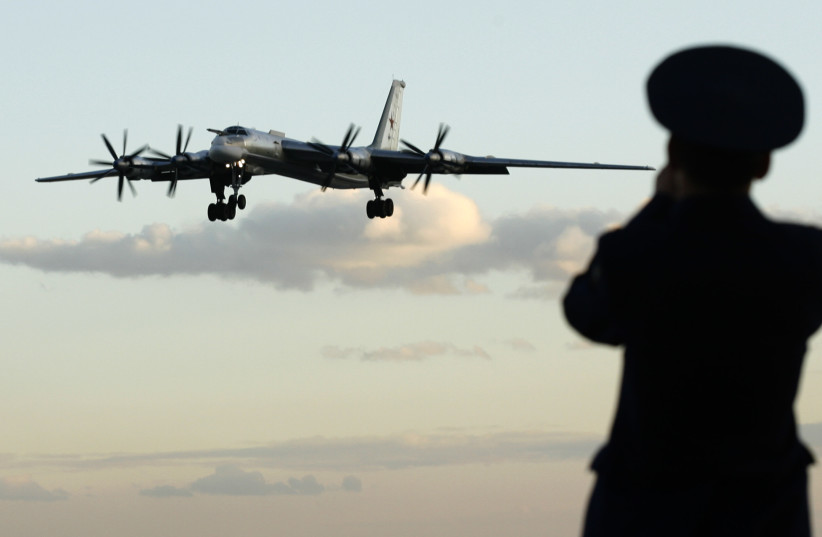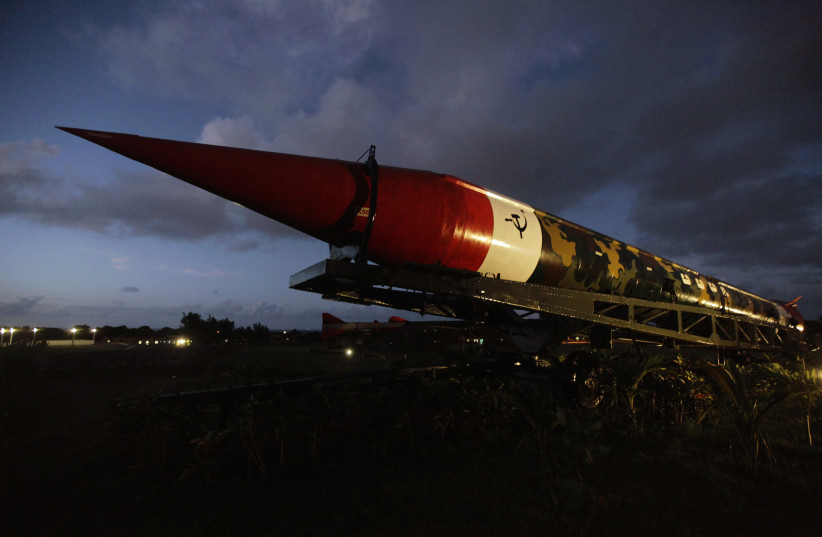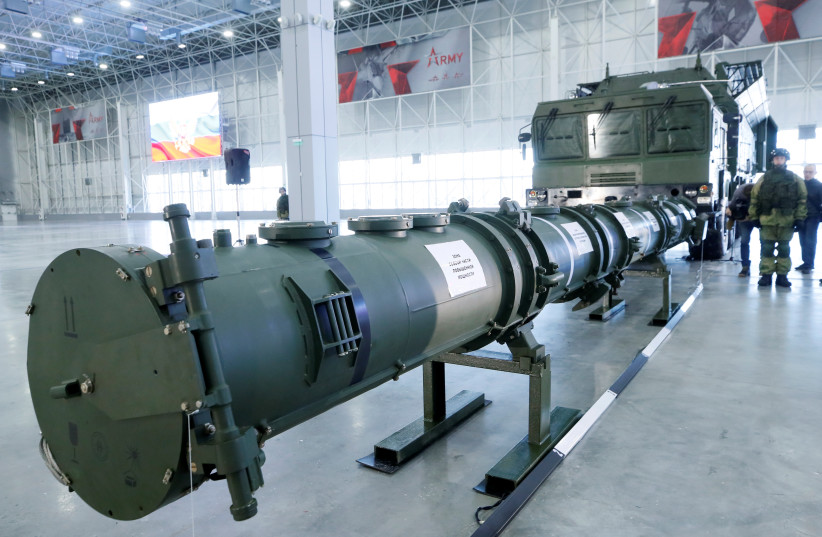Recent threats by Russian president Vladimir Putin have put the world’s powers on edge as they weigh whether the Ukraine conflict could escalate to the use of nuclear weapons by Russia. Over the weekend, Israeli intelligence firm ImageSat International (ISI) said it had detected an “irregular presence” of Russian TU-160 and TU-95 strategic bombers deployed to the Olenya Airbase near Finland.
According to the satellite images, four TU-160s were detected on August 21, and three TU-95s were detected on September 25. Both of these aircraft have the capability to carry nuclear weapons.
According to an article published by the Federation of American Scientists (FAS), “The TU-160 is a multi-mission strategic bomber designed for operations ranging from subsonic speeds and low altitudes to speeds over Mach 1 at high altitudes. The two weapons bays can accommodate different mission-specific loads, including strategic cruise missiles, short-range guided missiles, nuclear and conventional bombs, and mines.”
At the same time, Russia has access to tactical nuclear weapons, and some pro-Moscow voices have suggested that Russia could use these systems. Ramzan Kadyrov, the leader of Chechnya, has suggested that Moscow should consider using a low-yield or tactical nuclear weapon in Ukraine.

How many nuclear weapons does Russia have in its possession?
An FAS report in 2022 said Russia had 5,977 nuclear weapons. Of those, Russia has 1,588 that are classified as “deployed,” while the rest are in reserve or retired. That means Russia has access to some 1,500 older nuclear-weapon stockpiles and another 2,889 that are “retired.”
Overall, Russia’s stockpile of weapons has declined significantly from an estimate of some 40,000 that they were thought to have possessed in the 1980s. Since 2000, the arsenal has declined even more, going from around 10,000 of these world-destroying missiles to just over half that amount.

The most recent study of the Russian nuclear-weapons arsenal, also conducted by FAS this past February, gives us a glimpse of these weapons on the eve of the war in Ukraine.
What nuclear weapons does Russia have in its arsenal?
Russia has 812 land-based ballistic missiles fitted with nuclear warheads. Anothre 512 of these missiles are placed on submarines and can be launched from underwater. There are thought to be an additional 200 missiles at heavy bomber bases. The rest of the nuclear weapons possessed by Russia are in storage, including 977 strategic warheads, along with 1,912 nonstrategic warheads.
How powerful are Russia's nuclear weapons?
Bombs are measured in kilotons of TNT, with smaller bombs averaging one kiloton, or 1,000 tons of TNT.
Larger weapons will be more than 100 kilotons, and for strategic weapons, up to 1,000 kilotons. The bomb dropped on Hiroshima in 1945 was 15 kilotons. Russia’s largest nuclear bomb, the Tsar Bomba, was tested in 1961 and is thought to have been some 50 megatons, or 50 million tons, of TNT.
What systems does Russia use for its nuclear weapons?
One system used by Russia is the SS-18 (also called the “Satan”), a massive missile that weighs 191,000 kg. It contains multiple reentry vehicles that can be targeted, allowing it to carry multiple missiles.
It has a two-stage liquid propellant, and depending on the type, it has a range of up to 16,000 km. However, most of these older missiles were retired, and recent versions have either one large warhead or multiple warheads. A new missile called SS-X-30 (also known as the Sarmat) is being developed and is supposed to replace these missiles.
The Sarmat, or RS-28, is one of six Russian strategic weapons that Putin has been pushing for the last decade. It also includes a MIRV, or multiple reentry vehicles, to carry multiple warheads.
Another system, the SS-27, has been in service since 1997 in various models and was deployed in 2010. It is a solid-fueled ICBM and can fly 11,000 km. with a warhead up to 1,200 kg. The missile was first put in SS-19 silos, and these were deployed for a decade until the missile was also put on large trucks that can work as mobile carriers. Russia sought to make 350 of these missiles, but then it began to work on a missile called the SS-24.
According to the Missile Threat website, “Following the implementation of New START, Russia possessed 15 road-mobile and 50 silo-based Topol-Ms. According to a 2013 US report, there were approximately 80 operational missiles.”
Underwater nuclear missiles
For Russia’s submarine fleet of nuclear-capable missiles, there is the older missile known by its NATO reporting name, SS-N-23 Skiff, and the more modern R-29RMU2 Sineva. These missiles could initially fly some 8,300 km. and carry a 2,800-kg. warhead and up to four multiple warheads. According to Missile Threats, “The missile uses a three-stage liquid propellant engine and is 14.9 m. in length, with a maximum width of 1.9 meters.”

These were developed in 1973 and tested in the 1980s. Russia once had more than 100 of these missiles and began to extend their lives by creating a program called “Sineva.” Russia has dozens of these, according to reports.
Airborne nuclear missiles
In the air, Russia has the TU-95 Bear, a large intercontinental bomber developed in the 1950s, although it has since been updated many times.
According to the Global Security website, “The Kh-55 has been in Russian service since 1984 as a nuclear-armed air-launched cruise missile. The missile carries a 200-kt. [kiloton] nuclear warhead. The Kh-55 is the Soviet counterpart to American AGM-86 ALCM cruise missile. The Kh-55 cruise missiles are deployed with strategic bombers TU-95 MS and TU-160. Each TU-95MS bomber can carry up to six X-55 missiles, located on catapult-type launching drum installation in the bomb compartment of the aircraft. In addition to the internal rotary launcher, the Bear can carry more Kh-55s externally, though in an overload flight condition.”
The Tupolev TU-160, which has been in service since the late 1980s, is Russia’s more modern nuclear bomber and is equipped to carry the Kh-15 short-range nuclear missile. According to the Ukrainian website NV, “The TU-95 and TU-160 strategic bombers were developed in the USSR in the early 1950s and early 1980s, respectively. These jets are some of the most powerful and largest in the world. Among other things, they can carry nuclear weapons.”
“The maximum takeoff weight of the Tu-160 is 275 tons, and the maximum mass of its combat payload is 45 tons,” NV said. “The bomber can rise to a height of 16 km., develop a speed of up to 2,230 km/h and fly up to 14,000 km. without refueling.”
Russia could use smaller tactical nuclear weapons as well. These would be weapons with a shorter range, and they can be of smaller amounts of blast, such as one kiloton or tens of kilotons.
Ground-launched nuclear missiles
Russia also has a missile called the SSC-8, a ground-launched cruise missile (GLCM). According to the Missile Threat website, “In January 2014, the United States informed its NATO allies of a Russian missile that violated the range and launcher regulations of the Intermediate Nuclear Forces (INF) Treaty.”
In a July 2014 official compliance report, the United States found the “Russian Federation in violation of its obligations under the INF treaty not to possess, produce, or flight-test a GLCM with a range capability of 500 to 5,500 km., or to possess or produce launchers of such missiles. While the missile was not named at the time, analysts today acknowledge the SSC-8 is the non-compliant missile referred to in the report.”

Russia is believed to have 20 of these. The FAS report that links to an article by the Bulletin of Atomic Scientists said: “This figure assumes five SSC-8 battalions, each with four launchers, for a total of 80 missiles. It is assumed there is at least one reload for at least 160 missiles. Most are thought to be conventional, with 4-5 nuclear warheads per battalion for a total of about 20.”
Russia's nuclear weapons may no longer be useable
In a recent CNN piece, former British army officer and former commander of the UK and NATO Chemical, Biological, Radiological and Nuclear (CBRN) Forces, Hamish de Bretton-Gordon, discussed this issue of Russia’s nuclear capabilities. Asked about the tactical nukes, he said Russia’s warheads and missiles “are probably in reasonable condition, but the vehicles they are mounted on are, I believe and have on good authority, in poor condition. Judging by the state of the rest of the Russian Army equipment on show in Ukraine, this is a fair assumption.”
“I believe Putin’s tactical nuclear weapons are unusable,” he said. “Even if their vehicles do work, the minute they turn their engines on to move, they will be picked up by US and NATO intelligence.”
This means Russia’s tactical nuclear option may be weaker than the Chechen leader has indicated in recent comments.
While Western officials think Putin is trying to deter the West, an article at ABC News said: “Even a low-yield nuclear weapon used on the battlefield, aside from killing troops in the immediate vicinity, would still contaminate a broad area and expose large numbers of civilians in densely populated Ukraine and neighboring countries to radiation risks. In fact, Russia and its ally Belarus would face the highest contamination risk because of prevailing winds.”
